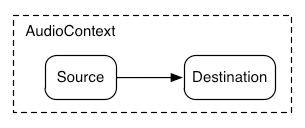Building Web-Based Audio Player for Obscure Audio Format

Outline
- Definitions
- Stories
- Lessons
Motivation


BRSTM
- File format
- Audio data, with loop point!
- Used in Nintendo Wii
- Popular in Nintendo modding community

Why recreate it on web?
How to play audio on web?
<audio />
HTML's <audio /> cannot play BRSTM!
So how?
Let's start an audio player project
But first, we need a name
Neeku Vozo

via
Wookiepedia (Star Wars Fandom wiki)
(fair use)
Nikku
github.com/kenrick95/nikkuIdea (1)
ffmpeg
Big idea
- ffmpeg converts BRSTM to MP3
-
Play using
<audio src="music.mp3" />
Solved?
No, it's not able to loop
Idea (2)
Live stream
Big idea
- Server serves the latest audio chunk continuously
- Client listens like listening online radio
Live streaming protocols
- HLS: HTTP Live Streaming (old Safari/Edge)
- DASH: Dynamic Adaptive Streaming over HTTP (all other browsers)
The idea
- Server implements DASH protocol
- Client listens using DASH client library
Is the complexity getting out of hand?
What's the user flow like?
Project reset
Two big ideas
| Static | Server |
|---|---|
| SPA | Client-server |
| User "uploads" BRSTM | User uploads BRSTM |
| JS/WASM decode | Server converts to MP3 |
| Web Audio API plays |
HTML <audio /> to play or live streaming
|
Two main problems
- How to decode BRSTM
- How to play audio using Web Audio API
Extracting audio out of BRSTM file
<crash-course>
in Digital Audio
Analog to Digital
via
Aquegg
(CC BY-SA 3.0)
Pulse-code modulation (PCM)
- Analog sound wave
- Sampling
- Quantization
- Bit depth
- Sample rate
Audio channels
via
Fillbit
(CC BY-SA 4.0)
4-minute track from a CD 💿
- Sample rate: 44100 per second
- Channels: 2
- Bit depth: 16 bits per channel
- Length: 240 seconds
-
44100 /s × 2 × 16 bits × 240 s
= 338,688,000 bits! ≈ 42.336 MB
Why your 4-minute audio file does not take up 42 MB of space?
Because compression!
Compression
- Coding format: MP3, AAC, FLAC
- Codec: encoder & decoder program
- Container format: .mp3, .m4a, .flac
</crash-course>
Extracting BRSTM
For real

Overview
- Container Format: BRSTM
- Coding Format: PCM or ADPCM
- Other metdata specified in file
So I started a simple page that accepts a BRSTM file and read its metadata
It works. What's next?
Audio Player
Web Audio API

Buffer Source node → Audio Context destination node
const audioContext = new AudioContext();
const bufferSource = audioContext.createBufferSource();
bufferSource.connect(audioContext.destination);
Get PCM samples from BRSTM
const pcm = brstm.getAllSamples(); // TODO: Implement
Transform PCM into audio buffer
const audioBuffer = audioContext.createBuffer(
1, // number of channels
pcm.length,
metadata.sampleRate
);
audioBuffer.getChannelData(0).set(pcm);
Write into source node, and plays it
bufferSource.buffer = audioBuffer;
bufferSource.start(0); // start immediately
Decoding ADPCM
This is the coding format
How to turn ADPCM into PCM?There should be a NPM package for this
 imaadpcm
imaadpcm
😱

and the input/output looks as expected!

🕵️
ADPCM
so many of them ...
Decoding Nintendo ADPCM
That means I can't use that npm package
sighHow did they do it?
ffmpegHow did they do it?
BrawlBox
Attach debugger!

ADPCMState.cs
Eureka!

Is it finished?
No

Audio Player
Web Audio API Gotchas
Audio Player
- Play/pause
- Display current playback time
- Seek
- Loop
Looping
Easy
// audioBuffer contains raw audio data (PCM)
audioBuffer.loop = true
audioBuffer.loopStart = … // in seconds
audioBuffer.loopEnd = … // in seconds
Play/pause
Easy
audioContext.suspend(); // pause
audioContext.resume(); // resume
Seek

// in <audio />
audioElement.time = … // in seconds
Seek (in Web Audio)
- Destroy audio buffer
- Recreate the whole audio node connect thing
-
Start playing at certain time
bufferSource.start(0, soughtTimeInSeconds);
Playback time display
Impossible
audioContext.currentTime
Playback time display (workaround)
Reimplement timer
Finally
Marketing

Posted to
r/BRSTM
and
a Nintendo modding forum.
Lessons
Kenrick
@kenrick95github.com/kenrick95/nikku
github.com/kenrick95/nikku-talk